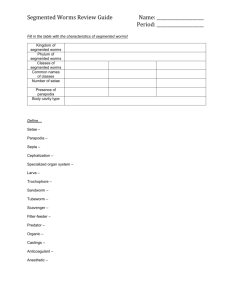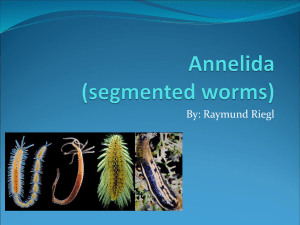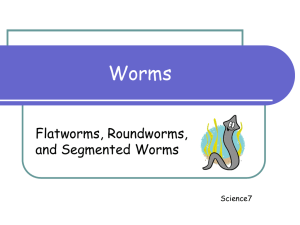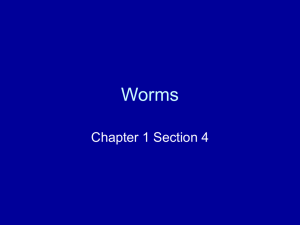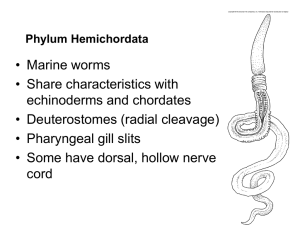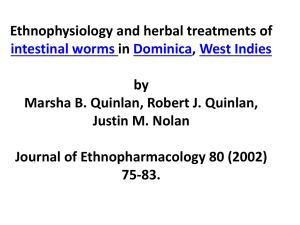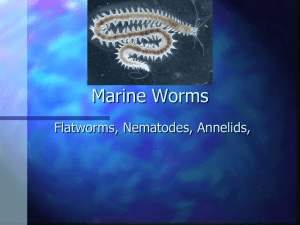Segmented Worms - Staff Web Pages
advertisement
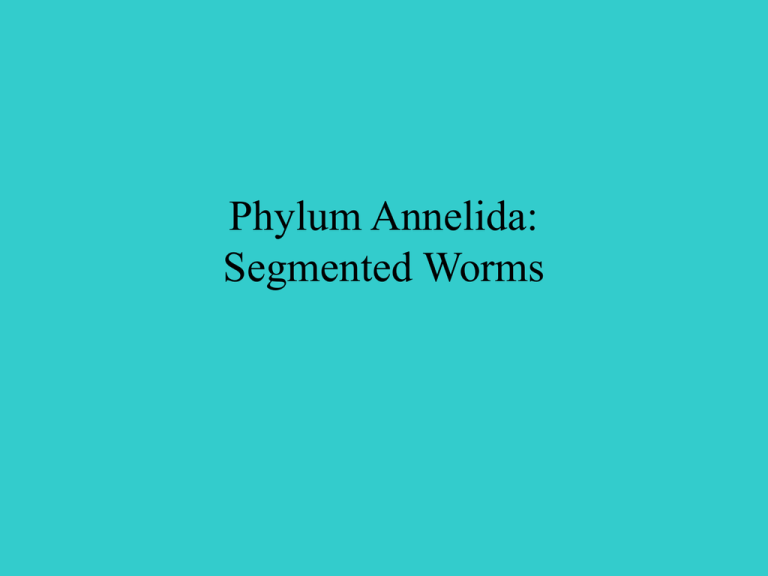
Phylum Annelida: Segmented Worms Segmented Worms (Earthworms, Bristleworms, and Leeches) • Segmented worms are classified in the phylum Annelida. They include leeches and bristleworms as well as earthworms. • Segmented worms are bilaterally symetrical and have a coelom and two body openings. Body Structure • The basic body plan of segmented worms is a tube within a tube. • The internal tube, suspended within the coelom, is the digestive tract. • Food is taken in by the mouth and wastes are released through the anus. Body Structure • Most segmented worms have tiny bristles called setae on each segment. • The setae help segmented worms move. They anchor their bodies in the soil so each segment can move the animal along. Setae Body Structure • The most distinguishing characteristic of segmented worms is their cylindrical bodies that are divided into ringed segments. • In most species, this segmentation continues internally as each segment is separated from the others by a body partition. Segments Body Structure • Each segment has its own muscles, allowing shortening and lengthening of the body. • Segmentation also allows for specialization of body tissues. • Certain segments have modifications for functions such as sensing and reproduction. Nervous system • Segmented worms have simple nervous systems in which organs in anterior segments have become modified for sensing the environment. • Some sensory organs are sensitive to light, and eyes with lenses and retinas have evolved in certain species. Nervous system • In some species there is a brain located in an anterior segment. • Nerve cords connect the brain to nerve centers called ganglia, located in each segment. Segments Setae Brain Nerve Circulation and Respiration • Segmented worms have a closed circulatory system. • Blood carrying oxygen to and carbon dioxide from body cells flow through vessels to reach all parts of the body. • Segmented worms must live in water or in wet areas on land because they exchange gases directly through their moist skin. Digestion and Excretion • Segmented worms have a complete internal digestive tract that runs the length of the body. • Food and soil taken in by the mouth eventually pass to the gizzard. Digestion and Excretion Crop • In the gizzard, a muscular sac and hard particles help grind soil and food before they pass into the intestine. Mouth Circulatory System Gizzard Digestion and Excretion • Undigested material and solid wastes pass out the worm’s body through the anus. • Segmented worms have two nephridia in almost every segment. These collect waste and transport it through the coelom and out of the body. Nephridia Reproduction • Earthworms and leeches are hermaphrodites, producing both eggs and sperm. • During mating, two worms exchange sperm. • Each worm forms a capsule for the eggs and sperm. Reproduction • The eggs are fertilized in the capsule, then the capsule slips off the worm and is left behind in the soil. • In two to three weeks, young worms emerge from the eggs. Reproduction • Bristleworms and their relatives have separate sexes and reproduce sexually. Reproduction • Usually eggs and sperm are released into the seawater, where fertilization takes place. • Bristleworm larvae hatch in the sea and become part of the plankton. • Once segment development begins, the worm settles to the bottom. Diversity of Segmented Worms Annelida includes three classes: • class Oligochaeta, earthworms • class Polychaeta, bristleworms and their relatives • class Hirudinea, leeches Oligochaeta: Earthworms • Earthworms are the most well-known annelids because they can be seen easily by most people. • As an earthworm burrows through soil, it loosens, aerates, and fertilizes the soil. Polychaeta: Bristleworms • Most body segments of a polychaete have many setae, hence the name. Polychaete means “many bristles”. • A polychaete has a head with well-developed sense organs, including eyes. Polychaeta: Bristleworms • Most body segments also have parapodia, which can be used for swimming or crawling over corals and the bottom of the sea. • Parapodia also function in gas exchange. Hirudinea: Leeches • Leeches are segmented worms with flattened bodies and usually no setae. • Many are parasites that suck blood or other body fluids from the bodies of their hosts (ducks, turtles, fishes, and humans). Hirudinea: Leeches • Front and rear suckers enable leeches to attach themselves to their hosts. • The saliva of the leech contains chemicals that act as an anesthetic. • Other chemicals prevent the blood from clotting. • A leech can ingest two to five times its own weight in one meal. Origins of Segmented Worms • Annelids probably evolved in the sea, perhaps from larvae of ancestral flatworms. Origins of Segmented Worms • Tubes constructed by polychaetes are the most common fossils of this phylum. • Some of these tubes appear in the fossil record as early as 540 million years ago.
